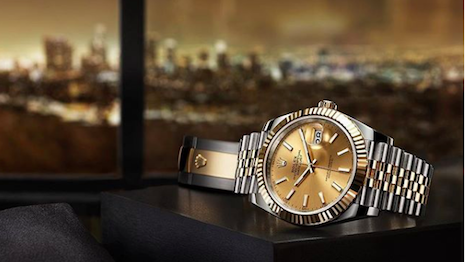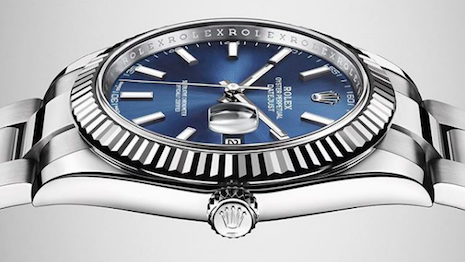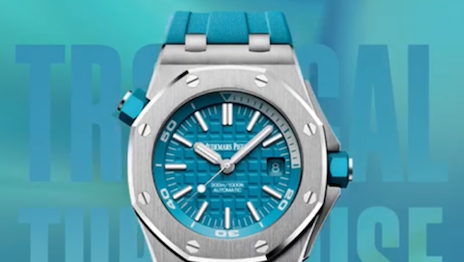 Rolex's the one to watch. Image credit: Rolex
Rolex's the one to watch. Image credit: Rolex
Online watch resale marketplaces are becoming more popular, but with their rise comes an increase in counterfeiters, and consumers cannot tell the difference between real and fake as well as they think. According to a report from RedPoints, 20 percent of survey takers had bought a fake watch online, and 43 percent judge the authenticity of watches based on the posting’s images. About 60 percent claimed to be concerned about buying counterfeit watches online, but 30 percent would buy fake watches at a 50 to 70 percent discount.
“It’s loud and clear from the report findings that buying watches is often a style-driven purchase, making watch buyers easy targets for those who use high-quality images and professional-looking websites to imitate companies with strong brand recognition,” said Laura Urquizu, CEO of Red Point. “More worryingly, our findings show that over a third of watch buyers are still falling prey to counterfeiters’ deceptive product images when shopping online.”
RedPoints surveyed a group of 18-to-45 aged consumers in the United States online who have purchased a watch online in the last three years. Spotting the fakes While 60 percent of watch buyers said that they are somewhat confident in identifying fakes online, after being shown pictures of fake watches sold online, 42 percent said they were no longer positive. The most common online platform for buying counterfeit watches was eBay, at 40 percent, and Amazon with 17.5 percent. Rolex is the leading Swiss watchmaker. Image credit: Rolex
Ten percent of survey takers claimed to have purchased Rolex watches online, which could be a risky move due to the brand’s high price point.
The more affordable brand, Timex, was the most popular brand to buy online, making up 12 percent of buyers.
According to respondents, style is the most important characteristic when buying a watch online, making up 21.2 percent of the survey. Style is followed by durability at 17.2 percent and affordability at 16.9 percent.
Google and Amazon are the most popular methods of discovering online watches by far, followed by eBay far behind.
However, social media is proving to be a more trusted space for watch discovery, as three-quarters of watch buyers would consider purchasing a product based on a social media ad. About 8 percent said they had bought a watch this way before but would not do it again, while 13 percent said they would again.
Rolex is the leading Swiss watchmaker. Image credit: Rolex
Ten percent of survey takers claimed to have purchased Rolex watches online, which could be a risky move due to the brand’s high price point.
The more affordable brand, Timex, was the most popular brand to buy online, making up 12 percent of buyers.
According to respondents, style is the most important characteristic when buying a watch online, making up 21.2 percent of the survey. Style is followed by durability at 17.2 percent and affordability at 16.9 percent.
Google and Amazon are the most popular methods of discovering online watches by far, followed by eBay far behind.
However, social media is proving to be a more trusted space for watch discovery, as three-quarters of watch buyers would consider purchasing a product based on a social media ad. About 8 percent said they had bought a watch this way before but would not do it again, while 13 percent said they would again.
 Audemars Piguet revealed their new watch on Facebook. Image credit: Audemars Piguet
Peer reviews are an important aspect of online shopping in general, and this is also seen within the watch industry, as the most important ways of evaluating trustworthiness is through reviews and a product’s star rating, says the survey.
Additional insight
The watch industry is changing significantly with the rise of digital, online shopping and mobile devices.
Swiss watch brands need to keep abreast of findings such as these.
Jewelry resale platform TrueFacet is exhibiting how consumers are showing a growing interest in pre-owned high-end jewelry with powerful growth in the past year.
Sales of jewelry priced at $25,000 or more on TrueFacet have seen an 18 percent monthly growth. The platform also saw a 34 percent growth in the value of average orders (see story).
Swiss luxury group Richemont acquired Watchfinder, a premium pre-owned timepiece database from the United Kingdom, in another move that shows the importance of resale.
The full acquisition was announced June 1 and is expected to close this summer. The purchase sees Richemont moving further into the worlds of luxury watches and digital (see story).
Audemars Piguet revealed their new watch on Facebook. Image credit: Audemars Piguet
Peer reviews are an important aspect of online shopping in general, and this is also seen within the watch industry, as the most important ways of evaluating trustworthiness is through reviews and a product’s star rating, says the survey.
Additional insight
The watch industry is changing significantly with the rise of digital, online shopping and mobile devices.
Swiss watch brands need to keep abreast of findings such as these.
Jewelry resale platform TrueFacet is exhibiting how consumers are showing a growing interest in pre-owned high-end jewelry with powerful growth in the past year.
Sales of jewelry priced at $25,000 or more on TrueFacet have seen an 18 percent monthly growth. The platform also saw a 34 percent growth in the value of average orders (see story).
Swiss luxury group Richemont acquired Watchfinder, a premium pre-owned timepiece database from the United Kingdom, in another move that shows the importance of resale.
The full acquisition was announced June 1 and is expected to close this summer. The purchase sees Richemont moving further into the worlds of luxury watches and digital (see story).
“At Red Points, we use an advanced keyword-monitoring system with image recognition to detect IP infringements wherever they occur and protect consumers from the dangers posed by counterfeiters,” Ms. Urquizu said.
